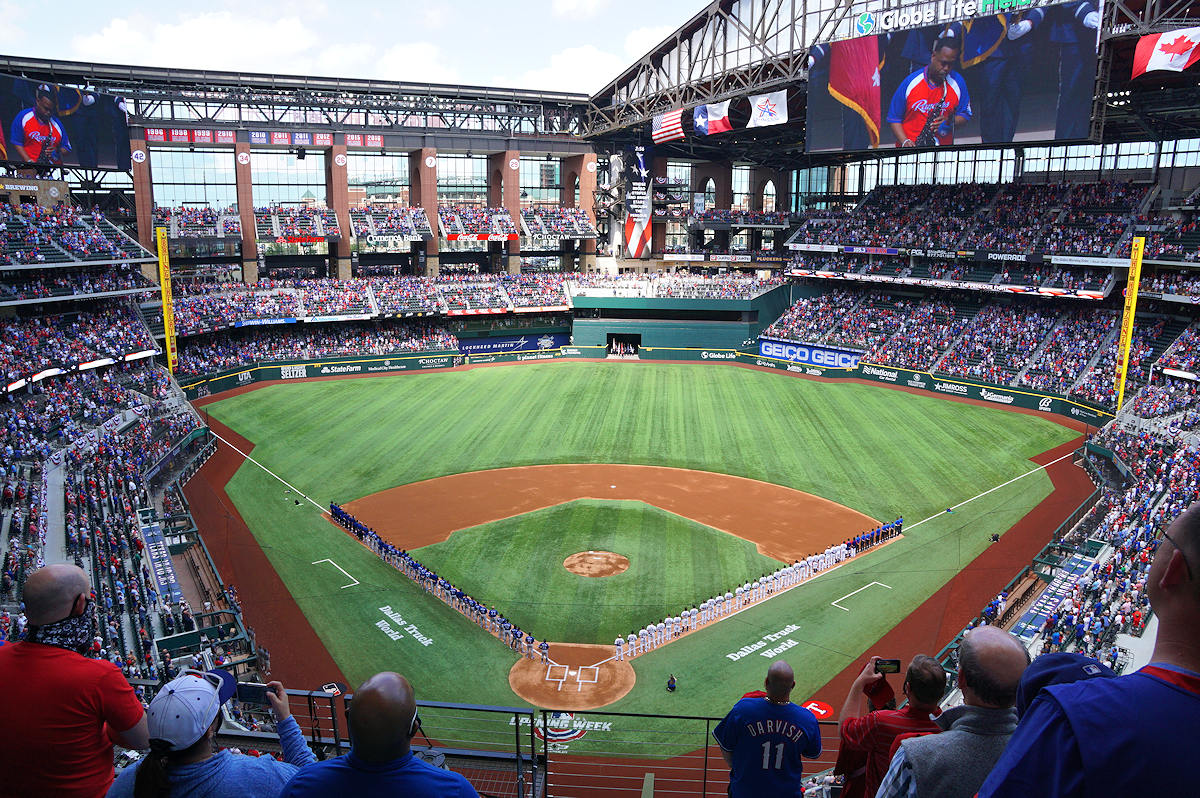
Article and all photos by Joe Mock, BaseballParks.com
All rights reserved
ARLINGTON, TEXAS If you really want to analyze a new ballpark to write an in-depth review, when should you visit it?
| Ballpark Stats |
 |
| Team: Texas Rangers |
| First game: July 24, 2020, a 1-0 win over the Rockies |
| Capacity: 40,300 |
| Dimensions: LF – 329; LCF – 372; CF – 407; RCF – 374; RF – 326. |
| Architect: HKS: Project Manager – Greg Whittemore; Principal Designer – Bryan Trubey; Principal In Charge – John Hutchings; Lead designer – Fred Ortiz; Sr. Project Architect – Thomas Smith |
| Construction: Manhattan |
| Price: $1.2 billion |
| Home dugout: 1B side |
| Field points: North by northeast |
| Playing surface: Shaw Sports Turf B1K (artificial) |
| Naming rights: purchased by Globe Life and Accident Insurance Company until 2048 |
| Ticket info: rangers.com/tickets |
| Betcha didn’t know: Even with the retractable roof open, air conditioning is pumped into the ballpark on warm days |
Construction on Globe Life Field, the Rangers’ new $1.2-billion home, was finished in March 2020, and was ready to welcome fans to two exhibition games. I was going to attend them — plus the home opener — of course, but then COVID shut everything down.
When the delayed 2020 season was ready to start, another two exhibitions were scheduled just ahead of the true Opening Night in July. Sure, I was there, but with no fans, there were no concession stands open. Heck, I couldn’t even walk around the ballpark because media members were confined to the pressbox.
Then came the true first game that counted, on July 24. Again, no fans, no atmosphere, no ability to roam around and see anything, nothing to experience anyway. I did the best I could to capture the night in an article, but it was hardly the kind of in-depth review that visitors to BaseballParks.com are used to.
Then came the announcement that “Bubble Baseball” was going to be the order of the day for the playoffs, and Globe Life Field would not only host four rounds, fans would be allowed at the NLCS and World Series.
So I bought tickets and was there for NLCS Game 1 on October 12th. Sure, it was awesome seeing the first game with fans (at any park), but the capacity was limited, and so was the number of stands and attractions, so I couldn’t really assess the gameday experience.
Fast forward to 2021. Buoyed by the State of Texas’ pronouncement that it was Open with a capital O, the Rangers not only announced that fans would be welcomed on Opening Day, but there would be no limits on seating. Every seat was available for sale, and with the sold-out crowd, all of the park’s eateries and attractions would be available to fans.
Finally, it was the right time to attend, photograph, take notes and experience. And what an awesome experience it was.
But before we get to that, let’s talk about how this new park came to be.
The Rangers’ 30-year lease at Globe Life Park, their previous home since 1994, was set to end after the 2023 season. It was common knowledge that some preliminary talks between the team and the City of Arlington had been conducted in 2015 and early 2016. The park was certainly still beautiful, but fans and potential free agents had long decried the unbearable heat inside the facility. As a Rangers fan, I know full well how terrible it was, particularly during July and August.
| The Castle |
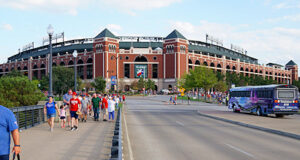 |
| A common nickname for Globe Life Park was The Castle, as it resembles a fortress atop a hill. The shot above was taken just after the final Rangers game there Sept. 29, 2019. Below, fans gathered to watch construction of the new park. BY THE WAY … as you’re reading this review, remember that Globe Life Park refers to the old ballpark. Globe Life Field is the new retractable-roof stadium. |
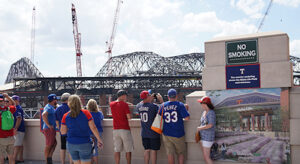 |
Unbeknownst to the public, the team had paid for engineering studies to see if a retractable roof could be constructed over the existing park to block or at least dim the unrelenting Texas sun. The problem was that even if the sun could be blocked, the air was still quite warm. With no air conditioning, the situation could only be improved slightly.
The nature of negotiations between the team and city were kept under wraps, so it was a big surprise when on May 20, 2016, the Rangers and officials from Arlington made a huge announcement. A new stadium would be built in the parking lot just to the south of Globe Life Park, pending City Council and voter approval. Four days later, the Council approved the master agreement unanimously. On November 8 that year, Arlington voters approved the referendum by a 20-point margin. A retractable-roof stadium with air conditioning would be ready by the start of the 2021 season.
Essentially, the deal extended the backing of bonds that paid for the construction of the Dallas Cowboys’ AT&T Stadium, just a quarter of a mile west of Globe Life Park. The new ballpark was truly a “public-private partnership,” but that phrase is often misleading. Usually there is a whole lot of “public” and only a little “private.” In this case, Arlington’s obligation was capped at $500 million. Since the stadium was projected to easily top a billion dollars, that put the Rangers on the hook for well over half of the cost.
For those keeping score at home, Arlington’s contribution was coming from a half-cent sales tax plus assessments on rental cars and hotel rooms. Helping the Rangers pay their share would be a 10% assessment on tickets and a fee for each space in team-controlled parking lots. The agreement between the team and city has created a lease that lasts until January 1, 2054.
Because the land was already under control (unlike when Arlington was starting construction on AT&T Stadium) and the architects at Dallas-based HKS had already started designing the new park, the timeline was moved up. As ground was being broken in September 2017, the team announced the new park would be ready for the 2020 season, not 2021.
A popular spot in Globe Life Park during the 2018 and 2019 seasons was on the top concourse behind right field. From there, you could clearly see the construction of the new facility just a few hundred yards away.
Following the Rangers’ final game at Globe Life Park on September 29, 2019, the architects from HKS gave me a thorough tour of the construction site of the new stadium. See my summary of that here. The place was 75% complete, and right on schedule to be ready in March 2020.
Little did we know then that a virus from China would wreck everyone’s plans in the spring and summer of 2020.
The Setting
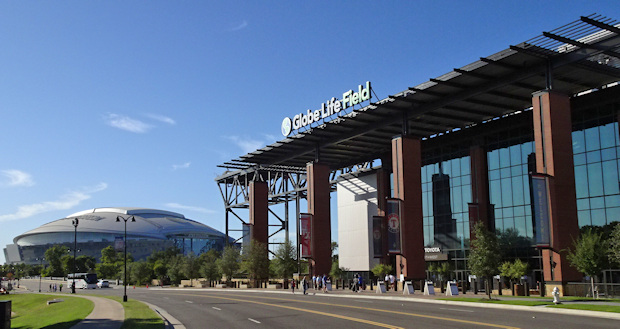
If you’ve never visited Arlington, Texas, you’ve missed quite an experience. The city of 400,000 is directly between Dallas and Fort Worth, and it prides itself on being an entertainment mecca. I don’t think anywhere else in the U.S. can match this area when it comes to sports and amusements.
If you’ve ever driven down I-30 in between Big D and Cowtown (OK, forgive my use of city nicknames), you couldn’t help but notice the immense Six Flags Over Texas theme park near the intersection of the interstate and the 360 freeway.
Also operated by Six Flags is the Hurricane Harbor water park, the biggest in Texas. Its 50 acres features colorful slides, a million-gallon wave pool and lots of squealing kids.
When it comes to sports, you have the old and new Rangers ballparks (the old park was not only used as the Rangers’ “alternate site” in 2020, it’s also been modified for football, soccer and rugby), and the Cowboys’ own retractable-roof stadium. There’s even the new Esports Stadium Arlington, which bills itself as the largest in North America.
Coming in 2024 is the brand-new National Medal of Honor Museum. This facility will celebrate the 3,500 men and women who have been awarded the National Medal of Honor, our country’s highest award for valor. The $150-million museum will be constructed just north of Globe Life Park.
The University of Texas at Arlington, a seven minute drive from the Rangers’ new park, has a competitive college-baseball program and a lovely new basketball arena that is home to the WNBA Wings.
And if that weren’t enough, just six miles east of Globe Life Field is yet another entertainment hub, this one in Grand Prairie. It features the Lonestar Park horse racing facility, a major concert venue, a minor league ballpark, a large skateboarding park and a Ripley’s Believe It Or Not museum.
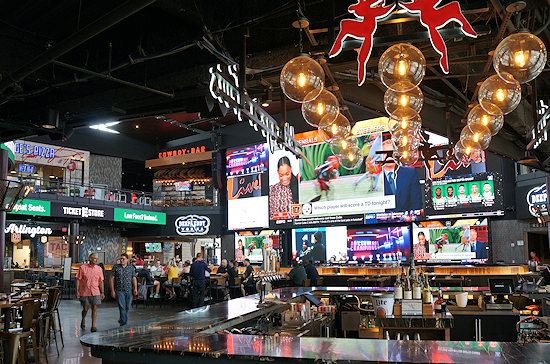
But the most vibrant of the Rangers’ neighbors is just steps from the North Entrance to Globe Life Field. Texas Live! (photo above) is a multi-level entertainment complex with restaurants, bars, shopping and live music, reminiscent of the Ballpark Village just outside of Busch Stadium in St. Louis and Xfinity Live! in the middle of the sports complex in Philadelphia.
Anchoring Texas Live! is one of the prettiest hotels I’ve ever seen: Live! by Loews. This 300-room boutique hotel features upscale dining, a gorgeous pool with big-screen TVs and a “swim-up” bar, and convention space.
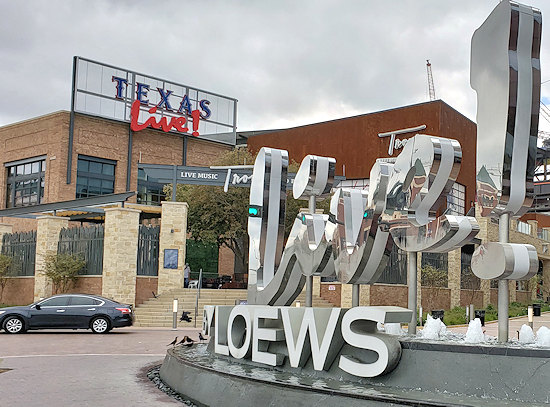
That’s by no means the only lodging near the entertainment district. I count 30 different hotel brands in the immediate area, and they run a free trolley service between the hotels and the area’s attractions.
So if you come for a Rangers’ weekend series, there is no end to the non-baseball activities for your family in close proximity.
The Exterior
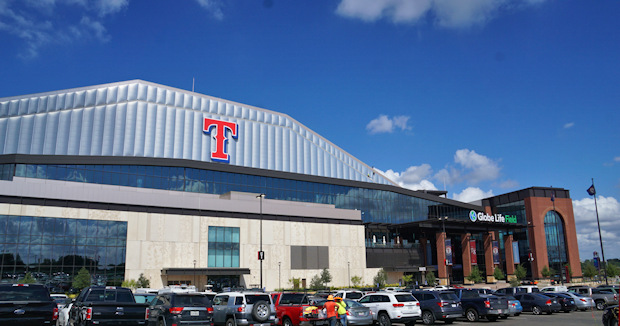
Everyone loves the air conditioning at Globe Life Field, but the exterior of the stadium is another matter. Opinions on it differ widely, but most opinions are based on what the critic thinks of the roof.
The roof isn’t just the 800-pound elephant in the room. It’s the five-and-a-half-acre, 24-million-pound elephant in the room.
The roof has to be tall — 230 feet above the playing field at its highest point — because the steelwork to support it has to be large. In fact, 19,000 tons (yes tons, not pounds) of steel was used to construct the five trusses that hold up the outer layer of the roof structure.
From a distance, the eye is drawn immediately to the roof. It’s impossible to ignore it, particularly because it is a stark light-gray color, which is quite in contrast to the beautiful masonry, dark glass and exposed steel in the rest of the exterior.
Now, we could argue the aesthetics of using a dark color versus a light color (my vote would’ve been dark, and I think the designers agreed), but the decision had nothing to do with how it would look. It turns out that International Building Code rules dictate that the color of a structure as large as this roof must be in a certain range of shades.
Hence, the light gray.
Regardless of the reasoning behind the color choice, this massive amount of gray has elicited scorn from many observers. I am not one of them, but I’ve read that some fans feel it looks like a Lowe’s Home Improvement store. One writer in the Fort Worth Star-Telegram referred to the park as Globe Life Hay Barn.
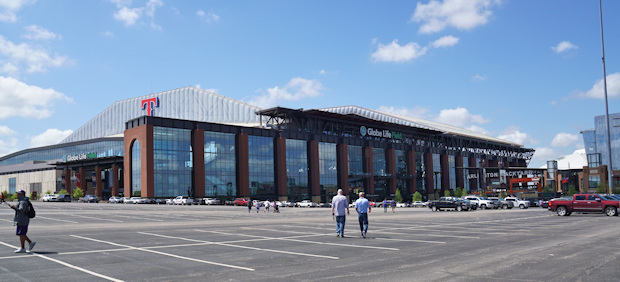
Another aspect of the the stadium’s structure that significantly influences the appearance of its exterior are the tracks on which the retractable roof slides back and forth. There’s no hiding them. That means the basic shape of the building is a rectangle, as the tracks more or less define the northern and southern edges.
Now, that allows for some fascinating design elements inside the stadium (like the colonnade with 18 beautiful arches above left field), but we’ll get to those in the next section.
A lot of effort went into making each of the main entry areas look different. In my opinion, that wasn’t necessary, because any of the four main entrances is attractive and could’ve been replicated at the other three (there’s actually a fifth entryway near the northwest corner of the structure, but it’s by no means a major entryway). But let’s look at each of the four main gates.
Many fans will enter the ballpark through the North gates, especially if you’ve just visited the eateries or bars in Texas Live! or are staying at the Live! by Loews, which shares a 100,000 square foot plaza with the ballpark. This plaza includes a water feature (that is exactly 60′ 6″ wide) where kids can splash to their heart’s content, as well as a statue of Nolan Ryan. This statue was inside the ballpark at Globe Life Park. You’ll always see fans having their picture taken here in front of the Ryan Express.
The exterior door to the souvenir shop and a number of box office windows are near the North gates.
 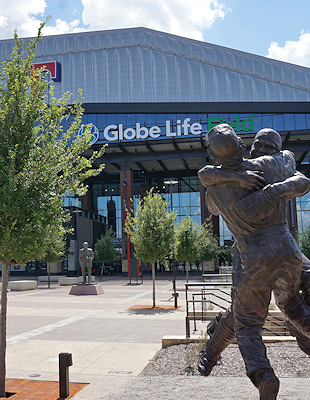 |
| Everyone wants to be photographed with the statue of Nolan Ryan by the North Gates. On the right, a series of statues greet fans as they approach the Northeast Gates. |
The Northeast Gate features two statues (with room for more) as you approach the park, each representing a photo opportunity. One statue created for the new ballpark is called Going to the World Series, which depicts closer Neftali Feliz jumping into the arms of catcher Benjie Molina seconds after clinching the franchise’s first pennant in 2010 — arguably the high-water mark in the history of the Rangers (since they’ve never won a World Series).
The Southeast Gate, which is also where visitors to the Rangers’ offices enter, has a covered drive-through area that is reminiscent of the drop-off spot in front of a luxury hotel. The walls of the building on either side of the entry are unlike the rest of the structure — most likely because these are the team’s offices. Here the walls are a light-colored sandstone and gleaming glass. It’s an attractive look.
 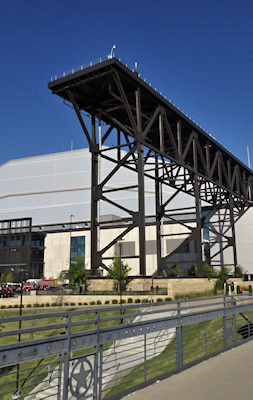 |
| This is the southeast entry which has a covered drive-through area. The other shot shows the west end of the stadium, which most fans won’t see. In this photo, the retractable roof is closed, which is why you don’t see it sitting on the tracks that extend westward from the ballpark structure. |
The other main entry area is on the southwest corner. This doesn’t get as much traffic since there isn’t as much parking on this side of the ballpark. Nevertheless, the doors here are just as attractive as the other entryways, plus there are several ticket windows here. There’s also a new statue of Pudge Rodriguez for fans to visit here.
All of the entries and the areas in between them (with one exception) have beautiful darkened glass and brick. The one area that doesn’t is the western edge (photo above), closest to AT&T Stadium. This is where deliveries are made and where the TV production trucks are parked. There’s nothing for the average fan to see here.
A lot of fans have likened the look of Globe Life Field to Minute Maid Park in Houston. I disagree. I think the Rangers’ new home is superior in just about every respect, including its aesthetics. This is particularly true of the exterior walls and entryways.
Now lets look at the impressive interior of the $1.2-billion showplace.